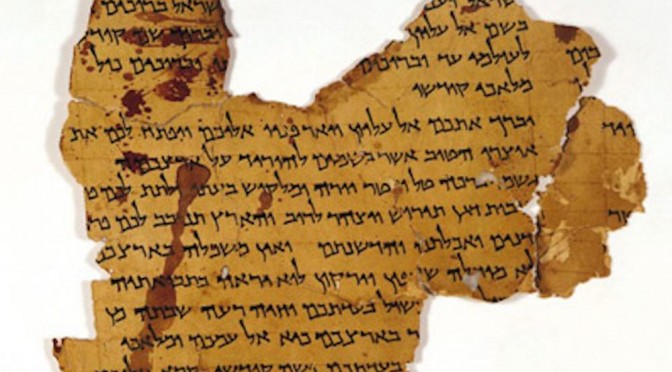The Written Record
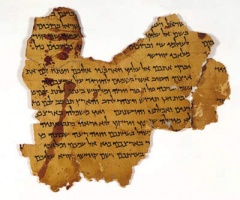
The written record gives a completely different story. Much of it has been derived from the records of the inquisition and a small number of documents, fragmentary in nature, which purport to be parts of a Cathar liturgy.
The gospel of John
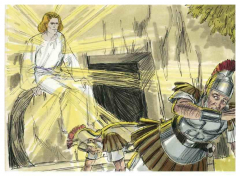 This written record shows a religion which makes extensive use of material from the new testament including the gospel of John. One major document is concerned with what is called ‘the secret supper’, a private conversation between the gospel writer John and Jesus.
This written record shows a religion which makes extensive use of material from the new testament including the gospel of John. One major document is concerned with what is called ‘the secret supper’, a private conversation between the gospel writer John and Jesus.
This is very puzzling. John’s gospel distinguishes itself from the other gospels by concentrating on the fact that Jesus is God. If the Cathars did not believe that Jesus was God then why would they be quoting from John?
The Lyon Ritual
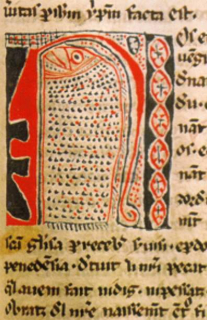
According to the documents known as the Lyon ritual the administration of the consolamentum is transformed from a simple laying on of hands to an elaborate ceremony. There is an Apareilementum , a confession and forgiveness ritual which is in direct conflict with other opinions which maintain that Cathars could only recieve forgiveness once, at the time of recieving the Consolamentum which is why many Cathars posponed recieving the Consolamentum until very late in life.
All the documents are in considerable conflict with each other, but what is most surprising is the conflict between the documents concerned with a “liturgy” and the Cathar’s supposed opposition to ceremonial.
This brings us to a situation in which though we must acknowledge the existence of the “liturgy documents” and that they have dated to the thirteenth century, their validity as Cathar documents must be subject to doubt. Perhaps there was indeed, as the Roman Church often suggested another “Christian Religion” seeking legitimacy.
The third church could have been quite different to the Cathars and closer to mainstream Church of Rome teaching and therefore was eliminated with greater ease and with less publicly.
Voinitch
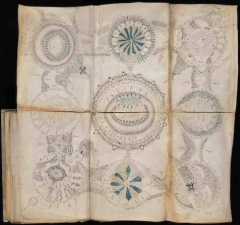
Which brings us to the Voynitch Manuscript. The Voynitch, in the collection of Yale University, where it is known as the Cyber Document, was discovered in Rome in 1912 by book dealer Wilfred Voynitch. It has profuse unusual illustrations and is written in code. In 2009 it was subjected to carbon dating by the University of Arizona to the late 14th early 15th century. i.e 1400. From a letter which accompanied the manuscript the ownership of the manuscript can be traced back to the Holy Roman Emperor, Rudolph of Bohemia (1552-1612).
The code is complex and could not be broken by expert code breakers using techniques which proved successful during World War II. However in 1987 Leo Levitov claimed to have deciphered the code and proved it to be a Cathar document indicating that the Cathar faith was a remnant of the Isis cult which was widespread in the Roman empire and outlasted the western empire. The temples to Isis were taken over by the Roman Church, after the council of Ephesus in 431, sanctioned the establishment of the cult of the Virgin Mary. Images of Isis and Horus were borrowed to become both the virgin and child and the black Maddona’s.
Levitov’s work has been severely criticsed on the grounds that his findings do not match either the liturgy of Lyons or the records of the inquisition however as has been seen above there are concerns about the validity of the liturgy of Lyons as a Cathar document
The Inquisition
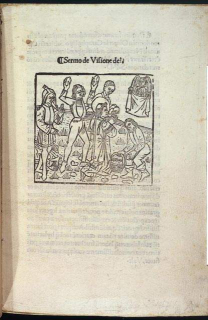
The other documentation available is the records of the inquisition and the observations of inquisitors.
There are a number of different documents. The most widely quoted is that of Renaldus, a Cistercian monk who was in Occitan at the time of the Albigensian Crusade. This document does seem to refer to the Cathars of the oral tradition, identifying the dualist belief, the rejection of the old testament, the difference between perfects and believers.
Significantly he refers to the Consulamentum specifically identifying how simple it is. He also identifies that the Cathars followed the teaching of a spiritual Jesus not the physical Jesus. This means that the teaching came from some source apart from the Christian Jesus. The problem is that it is difficult to put any reliance on anything which comes from such a biased source.
Bearnard Gui

Bernard was an inquisitor. His is observations are very different, concentrating on the ways in which the Cathars reject the Roman church and it’s sacraments. For Bernard this opposition is enough he does not concern himself with what the Cathars might actually believe.
Jaques Fournier
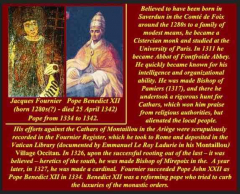
Jaques Fournier, Bishop of Palmiers took personal responsibility for the activities of the Inquisition in his bishopric. The execution of Guilliaume Belibaste was specifically his initiative. His claim to have eradicated the last vestiges of the Cathar Faith was the reason he was elected as Pope Benedict XII in 1334.
On his appointment as Pope, he took with him to Avignon the entire library of records of nine years of interrogations. They are still there in the Vatican library in Rome.
Montaillou
 The records deriving from the inquisition of a single village, Montaillou have been studied by the french historian Emmanuel Le Roy Ladurie and translated into english by Barbara Bray .
The records deriving from the inquisition of a single village, Montaillou have been studied by the french historian Emmanuel Le Roy Ladurie and translated into english by Barbara Bray .
Le Roy Ladurie’s intention was to get a picture of french village life in the fourteenth century. he makes little of no comment on the bias which might be inherent in the records originating in the horror of the inquisition. Once again there is little concern for what the Cathars actually believed. The occupants of Montaillou are made to seem poorly educated, dirty and lacking in any cohesive thought processes. Perhaps in this tiny isolated village that is exactly what they were but it does not seem appropriate to draw wide conclusions about the Cathar religion or the Culture of Occitan from this limited sample. the occupants of Montaillou were after all fighting to save their lives.
